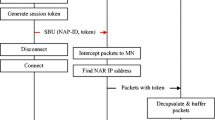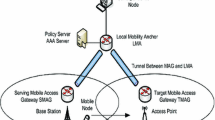Abstract
As IP has been extended from core networks to access networks, a mobile network can be considered as an overlay of a traditional cellular network and an IP network. SMS-MIPv6 attempts to integrate mobility management of these two kinds of networks. The basic idea behind SMS-MIPv6 is to exploit existing mobility management in the cellular network (i.e. in the form of well-defined short messages) to locate a Mobile Terminal (MT) in the IPv6 network. We should emphasize that the motivation of SMS-MIPv6 is not to replace or optimize existing mature mobility management schemes. On the contrary, as an entirely end-to-end mechanism for IPv6 mobility management, it provides an alternative mechanism for free peer-to-peer applications such as Voice over IP (VoIP) without support from mobile network operators. We describe the implementation of SMS-MIPv6 in detail and analyze its performance. The evaluation results show that SMS-MIPv6 achieves acceptable performance so that it can be deployed in most current mobile networks. It performs best in terms of signaling cost, data traffic overhead compared with Mobile IPv6 (MIPv6) and Proxy MIPv6 (PMIPv6). Moreover, SMS-MIPv6 can reduce the handover latency significantly, although it is considered as a mobility management scheme for global mobility. However, it increases the session initialization latency due to hybrid binding through the cellular network.
Similar content being viewed by others
References
Lin Y. B., Chlamtac I. (2001) Wireless and mobile network architectures. Wiley, New York
Johnson, D., Perkins, C., & Arkko, J. (Sept 2009). Mobility Support in IPv6, draft-ietf-mext-rfc3775bis- 03.txt (work in progress), IETF.
Gundavelli, S. (Ed.), Leung, K., Devarapalli, V., Chowdhury, K., & Patil, B. (August 2008). Proxy Mobile IPv6, RFC 5213, IETF.
Koodli, R. (Ed.). (Sept 2009). Mobile IPv6 Fast Handovers, draft-ietf-mipshop-rfc5268bis-01.txt (work in progress), IETF.
Soliman, H., Castelluccia, C., ElMalki, K. & Bellier, L. (Oct 2008). Hierarchical Mobile IPv6 Mobility Management (HMIPv6), RFC 5380, IETF.
Taniuchi, K., Ohba, Y., Fajardo, V., Das, S., Tauil, M., Cheng, Y., et al. (Jan 2009). IEEE 802.21: Media Independent Handover: Features, Applicability, and Realization, IEEE Communications Magazine.
ETSI TS 03.485., http://www.3gpp.org/ftp/Specs/archive/03_series/03.48/.
Zonoozi, M. M., Dassanayake, P., & Faulkner, M. (Apr–May 1996). Teletraffic modeling of cellular mobile networks, In Proceedings of the IEEE vehicular technology conference (VTC’96), (pp. 1274–1277).
Han Y., Choi J., Hwang S. (2006) Reactive handover optimization in IPv6-based mobile networks. IEEE Journal on Selected Areas in Communications 24(9): 1758–1772
Thomson, S., & Narten, T. (Dec 1998). IPv6 Stateless Address Autoconfiguration, RFC 2462, IETF.
Moore, N. (April 2006). Optimistic duplicate address detection, RFC 4429, IETF.
Author information
Authors and Affiliations
Corresponding author
Rights and permissions
About this article
Cite this article
Lu, H. SMS-MIPv6: An End-to-End Mechanism for IPv6 Mobility Management in Mobile Networks. Wireless Pers Commun 59, 217–235 (2011). https://doi.org/10.1007/s11277-009-9914-x
Published:
Issue Date:
DOI: https://doi.org/10.1007/s11277-009-9914-x




